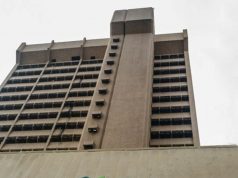MON 15 MARCH, 2021-theGBJournal- The share of unemployed Nigerians rose steeply to 33.3% in Q4, 2020, an increase from the 27.1% recorded in Q2, 2020, according to the Labour Force Statistics published today by the National Bureau of Statistics (NBS).
The NBS data shows that a combination of both the unemployment and underemployment rate for the reference period gave a figure of 56.1%.
That means 23,187,389 persons overall, either did nothing or worked for less than 20 hours a week. This is an additional 1,422,772 persons from the number in that category in Q2, 2020.
The NBS said the estimated number of persons in the economically active or working age population (15 – 64 years of age) during the reference period of the survey, Q4, 2020 was 122,049,400. This is 4.3% higher than the figure recorded in Q2, 2020, which was 116,871,186.
Of this number, females represent 50.49%, while males account for 49.5%. Further disaggregation by age group shows that the 30.2% of the total active population is within the ages of 15-24, the highest among the age groupings. The age-group with the smallest active population is 55-64, with 10,221,108 or 8.37% of the total active population.
The number of persons in the labour force (i.e., people within ages 15 -64, who are able and willing to work) was estimated to be 69,675,468. This was 13.22% less than the number persons in Q2, 2020. Of this number, those within the age bracket of 25-34 were highest, with 20,091,695 or 28.34% of the labour force. This is the estimated number of persons within the economically active population or working population, that are available and willing to work. This implies that as of Q4 2020, only 57.09% of Nigeria’s economically active population are in the labour force.
Unemployment rate among rural dwellers was 34.5%, up from 28.2% in Q2, 2020, while urban dwellers reported a rate of 31.3% up from 26.4%. In the case of underemployment among rural dwellers, it declined to 26.9% from 31.5%, while the rate among urban dwellers decreased to 16.2% from 23.2% in Q2, 2020.
The total number of people in employment (i.e., people with jobs) during the reference period was 46,488,079. Of this number, 30,572,440 were full-time employed (i.e., worked 40+ hours per week), while 15,915,639 were under-employed (i.e., working between 20-29 hours per week). This figure is 20.6% less than the people in employment in Q2, 2020.
For the period under review, Q4, 2020, the unemployment rate among young people (15- 34years) was 42.5% up from 34.9%, while the rate of underemployment for the same age group declined to 21.0% from 28.2% in Q2, 2020. These rates were the highest when compared to other age groupings.
Under State disaggregation, Imo State reported the highest rate of unemployment with 56.6%, this was followed Adamawa and Cross River States with 54.9% and 53.7% respectively.
The State with the lowest rate was Osun in the South-West with 11.7%.
For underemployment, the state which recorded the highest rate was Benue with 43.5%, while Lagos State recorded the lowest underemployment rate, with 4.5% in Q4, 2020.
The NBS said, a total number of 12,160,178 did not do any work in the last 7 days preceding the survey.
Twitter-@theGBJournal|email: info@govandbusinessjournal.ng









